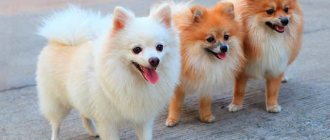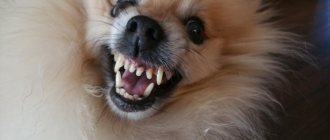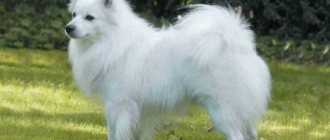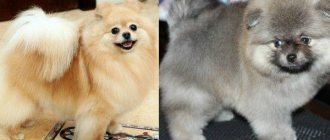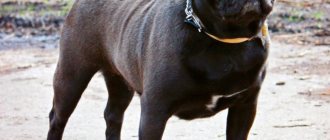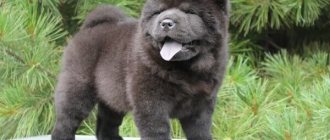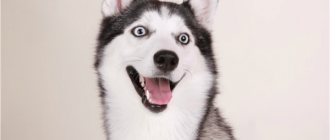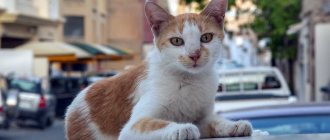Cute, doll-like appearance, cheerful, cheerful disposition, devotion to the owner. All this is he - a Pomeranian Spitz, a decorative dog, a faithful companion, a favorite of women. It is important to know the breed's character and the nuances related to caring for your pet in order to ensure its health and comfort.
Pomeranian Spitz - description of the breed
It has its own standard and features. The Pomeranian Spitz dog has the following description:
- She has luxurious fur and abundant undercoat, thanks to which the animal’s “hair” is located perpendicular to its body.
- The height of the animal at the withers (height) is 18-28 cm, weight is 1-3 kg.
- The life expectancy of a representative of the breed is 12-16 years.
- The dog's head is medium-sized and wedge-shaped.
- The Pomeranian Spitz's forehead is rounded, the animal's muzzle is smaller than this part of the head.
- The lips are pronounced, fit tightly to each other, and folds do not form between them in the corners.
- The dog has a scissor bite, less often a straight or pincer bite.
- The dog's nose is small and black in color.
- The animal's eyes are medium-sized, have a round, slightly elongated shape, and a dark color.
- The animal's small ears are located high and close to each other, have a triangular shape, pointed at the tips.
- The back of the Pomeranian Spitz is developed, short, straight, and the loin is wide, slightly convex.
- The length of the neck is average, but visually short, because it is covered with lush hair of the animal.
- The fluffy tail is curled behind the back, ring-shaped, and set high.
- The dog's paws are dry, straight and muscular.
Pomeranian Spitz - history of the breed
The animal is named after the place where it appeared. It is Pomerania, a Prussian province located in the northern part of what is now Germany. The history of the breed has its own important stages and information:
- The ancestors of the animal are considered to be northern sled dogs, and their close relatives are the Samoyed husky and the Eskimo dog.
- Initially the animal was not small. Work to reduce its size was carried out in England. They led to the fact that even the adult Pomeranian Spitz became miniature - the smallest compared to other Spitz dogs.
- The people of America also fell in love with the dog. It was there that the name of the breed was formulated.
What does a Pomeranian look like?
In appearance, the women's favorite resembles a miniature teddy bear. Depending on the breed and color, it may resemble a fox. His appearance is considered doll-like, but fans and breeders of the animal claim that he is capable of showing character. The Pomeranian Spitz breed touches with its small size, soft, fluffy hair, and beady eyes. Some exterior features may vary depending on the variety.
Pomeranian Spitz – colors
There are many of them. Black Pomeranian is one of the most common colors, but the following are also not less common:
- white;
- sable (red-black);
- chocolate;
- orange;
- black and tan;
- blue;
- blue and tan;
- cream;
- two-color (a combination of two colors in the form of a primary color and spots of a second color evenly distributed over the body).
Do Pomeranians shed?
This process is natural for representatives of the breed. The mini-bear Pomeranian sheds its first coat at 3.5-4 months, when puppy fluff is replaced by fur. He sheds the center hair, which is noticeable visually, and the change of thick undercoat often occurs gradually. During the shedding period, the Pomeranian may look painful, but this is a normal process and has nothing to do with the deterioration of the pet’s health. By eight months, the dog has acquired a beautiful, thick adult coat. Throughout its life, the animal sheds twice a year - in autumn and spring, but not as intensely as in childhood.
What types of Spitz are there and how do they differ?
Spitz dogs can be divided into groups according to a variety of criteria. For example, hunting, draft, decorative and security. But the greatest interest for future owners is the division of dogs of this breed by size. If you are choosing a dog to live in an apartment, you should hardly pay attention to large individuals with a developed sense of security and territory. Such a dog will simply get bored at home and quickly become depressed.
We propose to divide Spitz into varieties:
- dwarf or miniature - their height at the withers does not exceed 20 cm;
- small - from 20 to 29 cm;
- medium - from 30 to 39 cm;
- large - from 40 to 50 cm;
- large - from 42 to 55 cm.
Despite the common standard features, all Spitz dogs have their own character traits, pros and cons of keeping them. Let's talk about them in more detail.
Tiny
From the name it becomes clear that such a dog will look more like a toy. Mini-Spitz grow no more than 22 cm at the withers. These are small teddy bears that will become excellent companions and will be ready to accompany their owner everywhere. These dogs cannot stand loneliness; they need constant contact with a person.
Pomeranian (dwarf) Spitz
The weight of the orange does not exceed 3-4 kg. Despite the decorative nature of such a dog, it needs active games. This is not a couch dog who will sleep all the time. The Pomeranian has inherited the character of his ancestors and during a walk he will boldly bully not only animals of equal size, but also larger individuals.
Babies come in cream, white, and red. There are two types:
- bearish;
- fox
Dogs get along well with other pets, but require a lot of attention. If it is not enough, they may become jealous and express dissatisfaction with hooligan antics. They love to bark loudly, notifying the owner of all interesting changes in the environment.
Cost - from 45 to 150 thousand rubles. Depends on the rarity of the animal’s color and exhibition prospects.
Small
The group includes representatives of the breed that do not grow more than 30 cm at the withers. Another name for such dogs is Kleinspitz. By the way, this group also includes standard Pomeranians, whose height reaches 28 cm. The weight of small representatives of the Spitz varies between 8-10 kg. But for an orange, this figure should not exceed 6 kg.
The life expectancy of small Spitz dogs is quite long - from 15 to 18 years. This is explained by good health and the absence of a large list of breed diseases. The quality of life of such a pet depends on the owner’s ability to provide him with active walks and constant intellectual activity. Dogs learn quickly and love the process of learning new commands.
However, Kleinspitz dogs have a unique character and may not get along with every family member. But others treat their four-legged pets calmly and friendly.
German Spitz
One of the most popular breeds in the group (weight no more than 10 kg). The life expectancy of a German is from 13 to 17 years. The standard provides color options:
- cream;
- grey;
- brown;
- carbonic;
- bright white.
Externally, dogs resemble a square. The tail is perkyly wrapped in a donut. The areas on the neck, chest and tail have longer hair.
His small size does not prevent the German from being an excellent defender and danger signaler. These dogs love a family that includes other animals. They are friendly and tireless in games and fun. Well trained, but require a firm hand. Otherwise, they may grow up stubborn and disobedient.
Cost: from 25 to 80 thousand rubles.
Volpino Italiano
Volpino (translated from Italian as “fox”) belongs to the group of small Spitz dogs, since its weight does not exceed 5 kg and its height is 30 cm. Another name for the breed is Florentine or Palace. Initially, Volpino could be seen on the streets of Florence, when they accompanied trade convoys with their ringing bark. Then the snow-white dogs moved and firmly settled in the palace chambers of the nobility.
Acceptable Volpino colors:
- bright white;
- beige;
- ginger.
The bark of this dog is in no way comparable to its miniature size. It is so loud and strong that a better guard against uninvited guests could hardly be found.
The cost of dogs of this breed reaches 90,000 rubles.
American
The American line of Eskimo Spitz has several branches that differ in size:
- toy - from 23 to 29 cm at the withers;
- mini - no more than 38 cm;
- standard - grows up to 48 cm.
The rarest and most expensive representative of the breed is considered to be of the “toy” type. Its weight does not exceed 4 kg. Eskimo representatives of the dog group do not have an approved standard; their description is based on criteria common to all Spitz dogs. It is believed that individuals of the Samoyed Laika were used in the breeding work. The smallest representatives of the American branch are used as companions. Larger animals successfully serve as guards and shepherds among the indigenous population of Alaska.
The breed is not recognized internationally, only by the US National Federation. The dog will be an excellent option for a family who wants to have their first pet. He will not only be an excellent playmate for children, but also an excellent guard. Eskies (as the dog is called in its homeland) have a very developed sense of territory and distrust of strangers.
Cost - about 60,000 rubles. It is worth understanding that the dog will not have documents that are recognized by the FCI.
Average
This category includes dogs whose weight can reach 17-20 kg and height 38-40 cm. The future owner should think twice before getting a fairly large Spitz. If you do not plan long walks with active games, such a dog is unlikely to suit you. A dog of this breed, constantly sitting at home alone, will demonstrate behavior that is similar in destructive power to a hurricane. This does not mean that the breed is characterized by bad behavior, it is just a natural reaction to boredom and accumulated energy.
Mittelspitz
The “medium” Spitz has a fairly compact size - height up to 36 cm, and weight up to 15 kg. The definition of average refers only to the size of the dog of this breed, its mental abilities are at the highest level. Dogs are playful and loyal. Among the representatives of the breed you will not find an aggressive or embittered dog. But gaps in training can turn a dog into a stubborn and unyielding dog.
They love children and get along well with other pets. It's better if they grow up together.
The average price is 40,000 rubles.
Japanese
Interestingly, this breed is recognized by all cynological federations of the world. The exception is American. The USA considered that Japanese dogs were very similar to mini-line Eskimo Spitz dogs, so they refused official recognition. The Japanese have snow-white fur, pointed ears and a pointed muzzle.
The homeland of the Japanese variety is Tokyo. Breeders bred the breed using individuals of exclusively snow-white shades.
A feature of the breed is considered to be pathological sensitivity. This does not mean that the dog will show aggression in response to an insult. But he is able to show the owner that he is very upset by his behavior and will punish him with a long period of “silence”. This dog is suitable for families with children who need an additional protector of the territory. The dog will not let strangers through, will not show aggression in response to children's pranks, but will simply walk away.
The average price is from 30 to 70 thousand rubles.
Large
The future owner of a Spitz should understand that the larger the representative of the breed, the more difficult it will be with him. Such dogs are suitable for living in a private home; their thick coat allows them to live in a spacious, insulated enclosure. Among the representatives of large Spitz dogs you can find dogs that will become excellent guards or share with a person his passion for hunting.
Grossspitz
A powerful dog with a height at the withers of about 45 cm, developed intelligence, and a sense of territory. A distinctive character trait is a pathological reluctance to obey. The breed was bred by French, German and English farmers as an assistant in grazing livestock. This is what explains the animal’s autonomy and independence. It is capable of making decisions on its own.
Standard colors of Grossies:
- black;
- white;
- brown.
Properly raised from childhood, the Grossspitz is distinguished by an easy-going character, respect for even the smallest family members and playfulness. If you are not ready to work with the puppy from the very first days, walking the dog for at least 40 minutes three times a day, this breed is not for you. Grosses feel very bad in the cramped conditions of a small apartment.
Average price of a puppy: from 25 to 60 thousand rubles.
Finnish
The breed has a complicated history. The reason is that selection was carried out simultaneously in two countries (Finland and Russia). The result was the emergence of two lines of dogs in one breed group. They differ slightly in appearance and character.
The Finnish Spitz is a classic hunting dog. With it, the future owner will be able to hunt bears, fur-bearing animals, upland game and rodents. Dense coat with a thick undercoat allows Finnish dogs to live in outdoor conditions. A private house is suitable for her, but not an apartment. In an urban environment, a dog will quickly get bored. She needs frequent walks, and not rare trips “every once in a while.”
The peculiarity of dogs of this breed is:
- fiery red fur (or red), most similar to a fox;
- arrogant character, which is expressed in ignoring the owner’s commands and frequent escapes.
Cost: within 50,000 rubles.
Large
These are dogs that often outgrow 50 cm at the withers, and their weight can reach 45 kg. It is worth understanding that only an experienced owner can handle such an animal. You should not get a large Spitz as your first pet and trust children under 14 years of age to walk it.
Wolfspitz (Keeshond)
Wolf Spitz owe their appearance to the Netherlands. At a certain period of time, dogs had a different name - “barge dogs”. It appeared because of the designation of the type of activity for which wolves were used - protecting barges from hordes of rats and mice. One of the largest Spitz dogs - weight up to 30 kg, height up to 50 cm.
The dog received its modern name because of its unusual color - black and gray hairs alternate in the general mass, and light “glasses” clearly stand out on the eyes. Dogs are very attached to all family members, especially children. They are able to tolerate not very neat games of younger family members.
They need long walks, active exercises, and constant games. Thick, fluffy coat requires careful grooming - combing.
Average price: 50,000 rubles.
Karelian bear husky
A large dog, reaching 57 cm at the withers. This is the only smooth-haired representative of the breed group. The main color of huskies is black. There are often white spots and tan marks. They are classic hunters, ideal for hunting large game. A character trait is the adoration of a single owner. Only with him the dog will go hunting and work effectively. Distrust of strangers does not allow the dog to go hunting with other people.
Before getting such a dog, you need to understand for what purpose the pet is being purchased and whether it will have to be housed later if it is not physically busy enough and gets bored at home.
Average cost: 60,000 rubles.
Eurasian
The Eurasier is both a Chow Chow and a Wolfspitz. This should not be surprising - after all, these are the breeds that participated in the selection. The height of males at the withers can reach 60 cm, for females the standard is lower - up to 56 cm. The color of the Eurasier can be any, with the exception of white. It’s interesting, but you can’t tell a puppy exactly what color his coat will be when he grows up. After shedding and the puppy fluff falls out, the shade will change. It will either be darker or lighter.
Despite their enormous size (males can weigh up to 55 kg), the dogs are distinguished by their flexible disposition, obedience and adore their owner. They are loyal to children and small pets. Even if you live in a private house, you should not place your dog in an enclosure. Such a life is not for him, he will consider himself abandoned and will quickly fall into depression. He needs constant visual contact with a person.
The average cost of a puppy is from 80 to 150 thousand rubles.
Pomeranian Spitz and German Spitz - differences
In our country they are not considered different breeds, unlike in America. Our fellow cynologists classify the Pomeranian as a type of German Spitz, but there are differences between them:
- The height at the withers of a German Spitz is 18-55 cm, and the height of a Pomeranian is 18-28 cm.
- The skull of the first has a fox shape, a smoothed frontal line. The bear-type Pomeranian and other varieties have a skull similar in structure to that of a bear.
- The face of the German Spitz is more elongated compared to the facial part of the Pomeranian.
- The former has all teeth present, while the latter often lacks premolars.
Education and training
To socialize a dog, it needs appropriate training. Spitz are an intelligent breed and easily accept commands that need to be taught to them. Without this, the dog becomes too active, runs around and barks for a long time.
Expert opinion
Anna Abramenko
An avid dog lover. Experience in veterinary medicine since 2009.
Ask a Question
It is advisable to train dogs to know their place and, when necessary, to maintain silence.
The dog requires a lot of time for physical activity so that it realizes its increased energy. By depriving her of this, she may become nervous and loud, barking for any reason.
Pomeranian Spitz - pros and cons of the breed
It has many advantages, but it also has its disadvantages. The bear-type Pomeranian has similar advantages to other varieties of the breed, and they are as follows:
- Playful, cheerful, cheerful character.
- Excellent hearing. This characteristic allows the Pomeranian to be not only a decorative pet, but also serve as a guard dog.
- Loyalty.
- Cleanliness. The Pomeranian Spitz's ability to clean its own coat and body is comparable to that of cats.
- High level of ability to adapt to environmental conditions.
- A representative of the breed knows how to live harmoniously with other animals.
- Good health.
The favorite of women also has disadvantages:
- He is considered a bully because he barks a lot. The reason for this may be lack of attention, strangers nearby, loneliness.
- Congenital problems with bite, which a veterinarian can help get rid of.
- Heavy shedding.
- Need for training. If it is not used, the dog can become dominant.
History of the origin of the breed
The Pomeranian is the smallest Spitz. This breed has been known since ancient times. In Europe, back in the Stone Age, there lived turf dogs, similar to modern Spitz dogs. They were large, strong, unpretentious. In the Middle Ages, these dogs were used as mounts and guards. In the 18th century, one of the small Spitz dogs came to Great Britain to Queen Charlotte. She liked the dog and became popular among the nobility.
At first these dogs were larger, weighing about 9 kg. But dog breeders tried to breed dwarf representatives of the breed. In the 19th century, selection began, the smallest individuals were selected. They had a flattened muzzle and fluffy fur. Back then these dogs were called miniature Spitz dogs. At the end of the 19th century, the new breed was officially recognized. Since such dogs were first brought from the German province of Pomerania, they were called Pomeranian Spitz.
The fashion for such miniature dogs has spread throughout Europe. They were bred by noble ladies as indoor decorative pets. White Pomeranians, the larger representatives of the breed, were popular back then. At the beginning of the 20th century, Spitz came to the United States. Amateur clubs appeared, and a breed standard was adopted.
Due to World War II, the breed almost disappeared. Its revival began in the 90s of the 20th century. An updated standard was adopted, according to which the dog should weigh 2-3 kg, height 18-22 cm. Mini varieties are not recognized by the standard, since they cannot participate in breeding.
Pomeranian Spitz - types
There are three of them, but only one of them meets the requirements of the standard. This is a dwarf Pomeranian. It is taken as a basis when dividing the breed into the following types:
- Bearish
. This type of dog is similar in appearance to chow chow puppies and bear cubs. The animal's coat is slightly shorter than that of other types of the breed, but it is thicker. He has small ears and a flattened muzzle. - Lysiy
. Representatives of this species have an elongated muzzle, a narrow chin, a small nose, and fluffy cheeks. The fox-type Pomeranian has long hair and paws. - Puppet
. This type of dog is called a toy dog. Its representatives are miniature, their muzzles are flat, and their eyes are set further apart than in other species of the breed.
Care
An excellent quality is the ease of caring for oranges.
Despite his fluffy long coat, there is no need to wash your dog frequently.
But you need to comb it regularly.
However, this is also a positive point, because with constant combing, you won’t have to frequently clean the entire apartment of hair.
How to choose a Pomeranian puppy?
Please pay attention to a number of important nuances:
- The puppy must be well-groomed and have clean, silky, thick hair.
- Its color must correspond to the standard. For example, if this is a Pomeranian white purebred Spitz without spots, there should be no admixtures of other shades in the color.
- The future pet should not be overfed, but should be well-fed.
- The presence of smudges under the eyes is a sign of the disease.
- The pink color of the conjunctiva and gum membranes is a sign of health.
- The dog's nose should be clean (no crusts) and moist.
- The puppy should have a good appetite.
- Pay attention to the conditions in which the future pet is kept by the breeder; they affect its development and health.
- It is also important how much a Pomeranian Spitz costs. Its price starts from $500. If the puppy has a good pedigree and meets the standard as much as possible, the cost of the animal can reach up to $5,000.
Puppy cost
When buying a Pomeranian baby, its price will be determined depending on its pedigree, purebred and the availability of documents. If we consider the option of participating in competitions, then the requests for a dog will significantly exceed the requirements for an animal to play the role of a pet.
This is interesting: Tips for buying a Spitz puppy
Their price ranges from 40 to 150 thousand rubles. In this case, the buyer receives a full package of documents and a guarantee in addition.
Pets that are not going to take first place in beauty contests will cost much less, in the region of 19 to 40 thousand rubles. They will also be purebred, but may not have top-notch winning qualities. And mixed species, not purebreds, will cost much less than the main two options.
Caring for a Pomeranian at home
It is believed that this breed can be adopted even by inexperienced dog owners. How to provide your pet with a full life:
- When you bring your pet into your home, prepare the optimal place for it to live. It should not be located near a radiator, a window, in a draft, or in a passageway.
- The Mini Bear Pomeranian, like its relatives of other breeds, is playful, so prepare toys for it in advance. They should not be easily torn, broken, or made of plastic. Latex toys are recommended in small quantities at once - it is better to acquire new ones gradually so that the pet does not lose interest in them.
- Do not let your puppy sit on sofas or chairs - he may fall and get injured.
- Until your pet is vaccinated, you should not walk it.
- The first visits to the street should not be long so that the animal does not get tired.
- Until the age of six months, a Pomeranian Spitz should not move up stairs on its own - this is fraught with high stress on bones, joints, and ligaments.
- A dog's nails grow quickly, so they should be trimmed every 10 days. When carrying out this procedure, you only need to cut off the ends so as not to damage the blood vessels.
- At 4-5 months. The animal replaces its milk teeth with molars. Make sure he has the correct bite. In some representatives of the breed, not all baby teeth fall out on their own, so the help of a veterinarian is necessary.
Pomeranian nutrition
When the puppy arrives at home, it is recommended that for the first 2-3 weeks you feed it the same food that it received from the breeder. Rules for what food to feed your Pomeranian Spitz and how often it should be done:
- You can provide your pet with ready-made food or natural food.
- If you have chosen ready-made food, it is advisable to alternate the soaked version with the dry one. Choose premium food (Royal Canin Chihuahua, Petit Senior, Royal Canin Yorkshire Terrier). The package should indicate the dosage in which the pet should be given food.
- If you feed your pet natural food, its menu should include lean meat (one third of the diet). Pomeranians can eat fish, but only boiled river fish. Give him this product a maximum of twice a week, but the portion should be twice as large as the portion of meat. During the week, you can give your pet two boiled eggs. You can diversify your diet with a small amount of chopped raw or stewed vegetables and herbs. You can pamper your dog with bones, with the exception of tubular ones.
- The optimal frequency of feeding a puppy up to three months of age is 4-5 times a day, up to six months of age - 3 times a day, over six months - 2 times a day.
Pomeranian coat care
The following measures will help maintain her beauty and health:
- The dog should be brushed 2-3 times a week with a special brush, moving in the direction of hair growth and against it. The Pomeranian thick-haired Spitz needs to be brushed before bathing.
- After water treatments, the pet should be dried with a hairdryer, combing it.
- It is necessary to comb out the undercoat only during the molting period.
- If tangles have formed, they need to be carefully plucked out.
- The Pomeranian's haircut can be classic - it is discreet, but helps to highlight the advantages of the coat. Art Nouveau grooming is used to highlight the silhouette. Animals are cut like a bear cub or a lion.
- It is recommended to bathe your pet once a month, covering the ear holes with cotton. Dry shampoos can be used to periodically clean the coat.
Basic commands
You will use some commands more often, others less often. But they will still come in handy to easily interact with your Pomeranian and even keep him safe in various situations.
- Aport. One of the most difficult teams. Many people perceive it as very easy and simple, but with many dogs you will have to work hard. This skill is used for other exercises: searching, searching, selecting an item and many others. Usually they are all used in service. When working out a command, “Aport” and “Give” are used, and a gesture is also used.
- Give. On the command “Give” the dog must give up the object.
- Lie. A connecting command that needs to be learned for other commands. In addition, it will not interfere at home or on the street.
- To me. You will need to use this command quite often. So start with it immediately after your Pomeranian puppy has learned his name. Never call the dog to punish, and do not scold if it comes on its own, even after mischievousness before it. This behavior on your part may alienate the animal.
- Place. A puppy or an adult dog must clearly know where his place is located. He can sleep anywhere, if you allow it, of course, but he must know this command. You can use it outside the home, marking the place with a leash or your favorite toy.
- Near. It is possible to teach your pet the “Near” command at any age, be it an adult dog or a small puppy. When you move to a new home, you should immediately think about training your puppy.
- Sit. One of the very first commands that a Pomeranian puppy should learn.
- Stand. The command is useful in everyday life, for example, for combing a dog.
- . The prohibiting command is one of the most mandatory and taming it begins from the first day the puppy appears in the house. Requiring the command “Fu!”, “No!”, “No!” - immediately stop the unwanted action.
How to train a Pomeranian?
The process must be taken responsibly, otherwise there will be no result:
- You need to start raising your pet when it arrives in the family.
- The first steps are training to use a tray or diaper, games at the right time and place, and your nickname.
- Bear-type dwarf Pomeranians and other species should not sleep in the bed with their owners or receive food from the table - such measures are necessary so as not to spoil the dog.
- When teaching an animal commands, they should be clearly spoken, and treats should serve as motivation for their implementation.
- It is necessary to convey to the pet what he can and cannot do, and concessions should not be made in this matter.
Content
- The main character traits of a Pomeranian: female or male?
- Character of the Pomeranian Spitz
- Basic commands
- Raising a dog
In this article you will learn what features of character and behavior are inherent in the Pomeranian Spitz. After studying this information about the temperament and disposition of the Pomeranian Spitz at different ages, you will get an idea about the breed. Find out how the character of a bitch differs from the behavior of a dog. We hope our article will help you figure out which gender of puppy is best for you.
Diseases of Pomeranian Spitz
The animal is characterized by good health, but there are diseases common among representatives of the breed:
- Periodontal diseases
. They develop due to dental plaque. The main symptom is difficulty eating. Twice a year, the dog needs to be examined by a veterinarian and the oral cavity must be sanitized. - Patella dislocation
. If a Pomeranian Spitz lives in the house, the puppy may be injured by excessive physical exertion. Excess weight can cause the problem. The main symptom is lameness and difficulty moving. Treatment often requires surgery. - Hypothyroidism
. If the thyroid gland fails, the cheerful Pomeranian may become drowsy, apathetic, and weak. With the disease, there is an increase in body weight, dry hair and skin. Treatment is selected by a veterinarian after examining the animal and identifying the causes of the disease. - Sinus node dysfunction syndrome
. This is a group of diseases associated with disruption of the heart. When they occur, an abnormal heart rhythm and weakness of the animal are observed. In some cases, treatment involves the use of a pacemaker.
Health
The state of health of the orange can be distinguished by its positive and negative aspects.
pros
Pomeranians enjoy good health. They rarely have genetic abnormalities. Also, during routine vaccination, the incidence of pathologies of the gastrointestinal tract, some acute respiratory viral infections, hepatitis and plague is sharply reduced. So, trips to the veterinarian with their pet will often be limited to preventive examinations for the owners of dwarf Spitz dogs.
Minuses
The negative side of the orange's health depends on the anatomical structure of its body.
The first most common pathology in dogs of the described breed is a problem with teeth.
In young individuals, milk teeth may not fall out in time, which creates a certain obstacle to the growth of molars. That is why you need to examine the animal’s mouth and, if a problem arises, seek medical help from a veterinary clinic to have the interfering teeth pulled out.
Such a problem as the occurrence of tartar has not escaped the Pomeranian Spitz. The stone grows due to the lack of proper care of the animal’s teeth and the accumulation of plaque on the enamel.
Dental calculus is an excellent breeding ground for the proliferation of various types of bacteria. Which inevitably leads to gum inflammation. This leads to a feeling of discomfort and pain in the dog. To prevent the appearance of tartar, it is necessary to regularly brush your pet’s teeth.
There is no need to use human toothpastes and brushes to clean your dog’s teeth. For these purposes, there are special oral hygiene products for dogs.
Due to the structural features of the dwarf Spitz's skull, where the transition between the forehead and nose is too sharp, they can often experience problems with the eyes.
When walking during strong winds, heat, or when there is an increased amount of dust in the air, dogs of this breed often begin to suffer from severe tearing. Hereditary eye diseases may include retinal atrophy.
Also, babies may have problems with the thyroid gland that appear from birth. As a rule, this is insufficient production of thyroid hormones (hypothyroidism). This condition is dangerous to the dog’s health and must therefore be adequately corrected with medication.
Pomeranians can suffer from epileptic seizures. Unfortunately, epilepsy cannot be cured. No matter how strange it may sound, dwarf Spitz dogs can suffer from dwarfism. This is a pathological condition when there is insufficient production of growth hormone, which causes dwarfism.
Pomeranians with dwarfism are often called "super mini Pomeranians."
Problems with the musculoskeletal system in the described dogs arise due to their small size and weak joint ligaments.
Features of behavior
The Pomeranian Spitz is especially loved among residents of megacities - a miniature, cute creature, distinguished by curiosity and courage, not typical of dwarf dogs.
Despite their height of 18 cm and weight of 2 kg, these born guards carefully protect the personal living space of their owners, carefully monitoring the suspicious behavior of their possible opponents.
At the same time, the dog, assessing the situation with the sharp gaze of its black, quick eyes, willingly demonstrates its no less sharp teeth.
The Spitz demonstrates its guarding skills everywhere and in various ways. The most common behavior for a guard dog is barking.
These small animals are unusually sensitive: any rustle or foreign smell can attract their attention.
If the dog's mood is characterized by increased anxiety, its loud, ringing voice can be heard incessantly.
It is not surprising that for many people with whom a Spitz lives next door in a multi-storey building, the mere mention of the name of the breed causes allergies.
In most cases, the owners are to blame for a dog's noisy behavior.
During the period of growth and maturation, the Spitz must undergo a course of socialization - training that would help the dog more fully understand the world around him and get used to its diversity.
The Spitz's low level of education is the reason for his excessive anxiety and suspicion, which are manifested by excessive barking.
Reviews
Oleg: “My friends asked me to sit with a Spitz for 10 days. I took my dog with me to the dacha, she was next to me all the time, affectionate and kind. She refused to eat dry food and only liked boiled chicken. Her owners trained her to do important things in a litter box and didn't take her out often, so she was afraid to go outside. The most significant drawback is the hair, which is everywhere, the dog shed for 2 months in a row.”
Victoria: “My dog prefers only one owner and ignores other people. On the street she is aggressive towards all dogs, so we walk her separately. There’s a lot of wool at home, but no matter what, we all love it.”
Julia: “Our dog is almost 6 years old. She annoys her husband because of her loud barking. When she behaves quietly, she simply has no value, but every time the doorbell rings, a frantic howl begins. Without training, the animal will become impudent. And yet, different diets cause him stomach problems, so you need to choose one thing, either food or regular food.”
Interesting Facts
The ancestors of the small fluffy Spitz dogs were northern sled dogs, which were bred in the Icelandic snowy expanses.
Many famous people choose to have an Pomeranian as a pet. Connoisseurs of this breed include the Osborne family, Sylvester Stallone, Elvis Presley, Paris Hilton, Maria Sharapova.
In some European countries, miniature Spitz dogs serve as caregivers for seriously ill people, due to their sensitive nature and intellectual development.
The Pomeranian came to England from Italy along with Queen Victoria, who had 6 such dogs, one of them, Marco’s favorite, was buried with Her Majesty.
The initial weight of the dogs was 15-16 kg.
